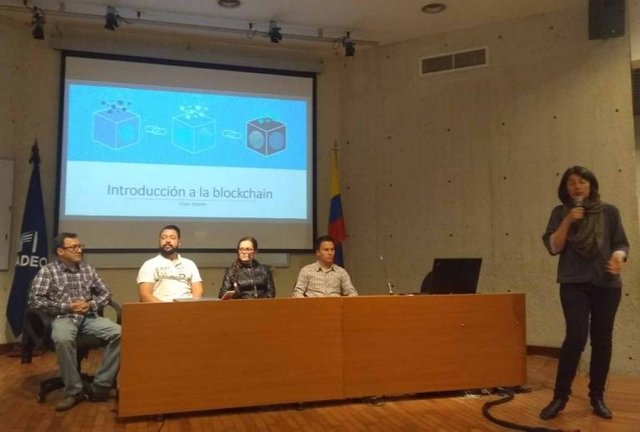Colombian University did open class on Blockchain protocols
The speakers shared some kindness about the networks in which they currently work, as well as the solutions they have developed with the associated technologies.
Last Saturday an open class was held in the auditorium of the Jorge Tadeo Lozano University in the city of Bogotá, an initiative promoted by those responsible for the subject "Introduction to the Blockchain", which aimed to share with attendees information associated with the benefits of the different block networks most used today.
The class had the participation of five special guests, all of them developers of Blockchain projects who spoke about their lines of work and about the network of blocks in which they operated as a priority, detailing the benefits they offer according to the nature of the initiatives in course.
Ethereum and NEM
The first presentations were given by Camilo Páez - project manager at Foonkie Monkey - and Carolina Velázquez - project developer - who spoke about the benefits of Ethereum and NEM respectively.
Páez valued what it means to operate in the Ethereum network, Blockchain by which he opted for the possibilities associated with the price of its digital currency and the design of smart contracts. He stressed that since Foonkie Monkey several projects have been developed both nationally and internationally, addressing pharmaceutical, electoral, banking, among others.
Among the most important aspects offered by Ethereum, Páez referred to the possibility of operating through a private network designed with the network code, also citing the benefits of programming with Solidity and how easy it is to learn to develop solutions with smart contracts Among the main limitations, he highlighted that the network processes very few operations per second and that it is necessary to operate with its digital currency to execute any process.
For his part, Velázquez highlighted the properties offered by the NEM network for the development of solutions, citing as strong points the fact that it can be operated either in the public or private network, enables communication between different networks of blocks , has a layer architecture with different modules for different services, among others.
Velázquez indicated that, unlike other networks, NEM can process more than 2,000 transactions per second and that it is possible to develop with many known programming languages. Among the projects he has worked on, he mentioned a proof of concept for the management of Blockchain notes using multifirm technology, as well as a job for the apostille of university documents in the block network.
Hyperledger and Tendermint
The following presentations were directed by Andrés Rojas -architect Blockchain- and Sergio Velandia -developer of solutions-, which addressed the properties of Hyperledger and Tendermint.
Rojas highlighted the differences between the networks of public and private blocks, indicating that Hyperledger is a Blockchain platform that operates in a closed form, which has been developed by the Linux Foundation in partnership with IBM in order to apply its benefits for the creation of use cases. Currently Hyperledger is divided into five more specific networks (Fabric, Burrow, Indy, Iroha and Sawtooth), which contemplate different functionalities that adjust to different types of solutions without having to operate with digital currencies for decentralized services.
The developer indicated that there are many cases in which this technology has been used, highlighting especially the areas of digital identity, management of medical records and supply chains. He stressed that currently it would be very useful to solve the problems of compensation between banks by decreasing the number of intermediaries, as well as could solve the mismatch between the EPS (Health Promoting Entities) and the IPS (Provider Institutions of Services) . Among the challenges posed by its use are the legal problems associated with the impossibility of erasing information and the fact that the consensus algorithm can be ineffective when there are more than 100 actors involved.
He then took the word Velandia and spoke about Tendermint, a platform that allows the creation of Apps in any known programming language, and that these operate directly in the Blockchain. It was highlighted that the network uses the same consensus algorithm as Hyperledger and that its nodes validate without the need to carry out traditional mining tasks, managing a pool for transactions, guaranteeing their verification in case of problems that threaten the operation of the protocol.
Among the main benefits offered by Tendermint, Velandia indicated that the protocol manages a multichain implementation with the Ethereum network, and that the use cases in which more applications have been developed are associated with the academic ecosystem, where the nodes validate certificates for avoid its falsification.
IOTA
The last presentation was in charge of Germán Jaimes, who explained in detail the operation of the IOTA network which raises differences with respect to the Blockchain networks commonly known as it operates based on the Internet of Things.
The network itself seeks the interconnection and exchange of information between IOT devices implementing a solution called Tangle, which includes the validation of two previous operations, guaranteeing in turn a possibility of infinite scaling and that the network can be supported by computers with low processing power, in addition to operating with programming languages already known.
IOTA is currently recognized by the German government and very interesting solutions have been developed in the country, such as a micropayment project in supermarkets and the development of digital car models with the Volkswagen company. In Colombia, two solutions are currently operational: The first is a network for vehicular transport with more than 400 trucks, which traces polygons on a map and records the passage of automobiles incorporating a photograph inside the vehicle (to verify that the same has not been hijacked). And the second has to do with a system for measuring data on farms in Antioquia to improve agricultural productivity.
As important points, Jaimes mentioned that the nodes of the network already run on Linux, and that the launch of the second part of IOTA (Cubic) is scheduled for the next months.

!cheetah ban
Plagiarism, Comment Spam